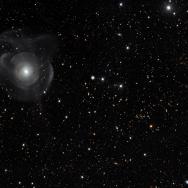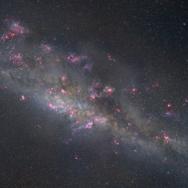You might say Richard Kron, professor of astronomy and astrophysics at the University of Chicago, was born to map the sky. Both Kron's parents were astronomers working at the University of California's Lick Observatory on Mount Hamilton. He recalls working at the telescope at night and making comments in the logbook at the age of 12. He loved the observatory library and grew up surrounded by its science books.
But for Kron, becoming an astronomer wasn't inevitable. Struggling with a math course in college, he was faced with a choice.
"I knew I couldn’t give up on it if I wanted to have a career in the sciences," he said. "I needed to do well in math. It was a make or break moment for me."
He buckled down, passed the course, and went on to lead a long career in astronomy and astrophysics, which culminates this year as Kron retires from the University of Chicago after over four decades in service of mapping the universe. His legacy includes helping to conceive and lead one of the most influential projects to map the sky, the Sloan Digital Sky Survey, as well as the creation of the astrophysics major at UChicago and the project to digitize and explore the scientific potential of 100-year-old photographic images of the sky from the Yerkes Observatory.
Mapping the sky
In the late 1980s, researchers knew that galaxies were clustered together according to certain patterns—what is called large-scale structure—and that these structures would reveal information about the early universe; however, they needed more data and computing power to understand these structures.
"We needed statistical measurements of the way galaxies clustered on large scales, as in billions of light years," Kron said.
In order to get the amount of data they would need, Kron and two colleagues—Don York, the Horace B. Horton Professor Emeritus of Astronomy and Astrophysics at UChicago, and Princeton University astronomer James Gunn—wanted to create a survey: a series of images and measurements of objects in a portion of the sky, that would be both big enough and precise enough to be able to constrain the clustering.
This idea was so ambitious that they knew they'd need a large collaboration with partners across the world to pull it off—an approach that was relatively novel in the field.
Today, it’s common for groups around the world to work together on large astronomy projects. But not so in the 1980s. "At the time, you would apply for observing time at a public telescope and might get six nights a year at best," York said. "And no two researchers would want to use their time the same way or take the same approach, so getting together a precise survey of one million objects was close to impossible.
"But our idea was that this would be a dedicated project with everyone pooling resources and all the data would be available to everyone involved."
The technology they'd need for their project—a camera using many charge-coupled devices (CCDs) that was 100 times more efficient than photographic plates—had recently become feasible to build, and they already had a site in mind for the telescope at a newly-built observatory at Apache Point, New Mexico.
"Rich is a real student of history, and with his knowledge of the history of astronomy and sky surveys, I think he realized the development of technology in the field was right for this next revolutionary step. It was quite visionary," said Joshua Frieman, UChicago professor and head of the Particle Physics Division at Fermi National Accelerator Laboratory.
York, Kron and Gunn began holding what would later be called the O'Hare meetings, a gathering of scientific leaders at the O'Hare Airport. Kron, the organizer, wanted to make sure everyone agreed on the scientific goals and the approach. From those meetings, they developed a proposal and began to fundraise, recruiting supporters and institutional partners. Kron also started working with Fermilab, building an experimental group there that would contribute to the project.
The Sloan Digital Sky Survey's camera took its first images in 1998, with the official survey beginning in 2000—over a decade after the initial O'Hare meetings. York served as the first director, and Kron was the third, finishing out part I of the survey and remaining in the role until part II was completed in 2008.
The Sloan Digital Sky Survey has created the most detailed three-dimensional maps of the Universe and recorded the spectra—light spread out across its component wavelengths—for more than three million astronomical objects.
The team made all of their data publicly accessible for anyone with an interest to download—another groundbreaking concept. The Sloan Digital Sky Survey data is the foundation of hundreds of studies, and its public data sets are still being used in countless research projects. It also set a precedent that has been followed ever since by major collaborations.
"The Sloan Digital Sky Survey is still, to this day, a very powerful and dynamic survey," Kron said, "And I feel proud of that."
When Frieman started to plan for the Dark Energy Survey—a survey of the southern skies aimed at uncovering the nature of dark energy by measuring the expanding universe with high precision—he was influenced by Kron's approach to creating the Sloan Digital Sky Survey.
"It was extremely helpful to have Rich's example of how to build, manage, and run a huge collaboration," Frieman said. "We had this working model to borrow from. We also had the lessons from what hadn't worked well in the Sloan Digital Sky Survey and were able to make modifications based on that."
When Frieman took on leadership of the Dark Energy Survey, he knew he wanted Kron by his side to help manage the project.
"He had the experience, knowledge, and calm temperament," Frieman said.
From data gathered over the course of six years (2013-2019), the Dark Energy Survey created one of the most accurate dark matter maps of the universe—revealing the amount and distribution of dark matter in our cosmos. It has also revealed thousands of supernovae, including the most distant supernova ever detected, as well as nearly 20 dwarf galaxies orbiting the Milky Way.
When Frieman stepped down as director of the Dark Energy Survey in 2018, Kron was the obvious successor. As with the Sloan Digital Sky Survey, the Dark Energy Survey's legacy will continue long past its collection of data. The Dark Energy Survey recently released a catalog of nearly 700 million astronomical objects to the public.
"Under his leadership, the Dark Energy Survey will publish its major cosmological results in the coming months and years," said Frieman.
A commitment to students
While mapping the skies, Kron has remained dedicated to the educational mission of the University of Chicago. He has shepherded several graduate students on to heralded careers and devoted creative energy to courses in the College.
"There is something about the culture and spirit of UChicago and its attitude toward undergraduate education that has always resonated with me," said Kron.
"He is committed to students. Everything he does is with passion, integrity and commitment," said Rocky Kolb, a longtime colleague of Kron's and the Arthur Holly Compton Distinguished Service Professor of Astronomy and Astrophysics.
In the early 1990s, Kron taught the first courses for the Space Explorers Program, an opportunity for local high school students to learn about space through weekly labs on campus and week-long residential stays at Yerkes Observatory, a facility formerly affiliated with the University located in southern Wisconsin. The program has lasted for more than 25 years and became an integral part of the Kavli Institute for Cosmological Physics.
In 2015, Kron stepped into the role of assistant chair for academic affairs for Department of Astronomy and Astrophysics, overseeing both the graduate and undergraduate programs. During his tenure, he and the administrator of academic affairs, Julia Brazas, began to develop a major and minor for astrophysics. Previously, students interested in astrophysics would major in physics and enroll in astrophysics electives. The new major and minor officially began in 2018, with the first class of nine students graduating in 2019.
"It has been a wildly successful program," said Kolb, "And a large part of that has been Rich's involvement."
Now, Kron is working with a group of 10 undergraduates and partners at the UChicago Library to mine historical glass slides from Yerkes Observatory for astronomical data.
"We're digitizing the plates and extracting science from the database," said Kron. "The students are learning a lot and we've published papers on our findings."
This Winter Quarter, Kron taught a course on the origins of photographic surveys and discussing how photography was a game-changer for mapping the sky.
Retirement, for Kron, is a milestone more than a destination. He plans to keep teaching, stay on as director of the Dark Energy Survey, and continue his research.
"I want to stay fully engaged," Kron said. "I feel like the dark energy problem is so deep and fundamental that it would be crazy not to stay involved and continue on."
—This story was first published by the Physical Sciences Division.

